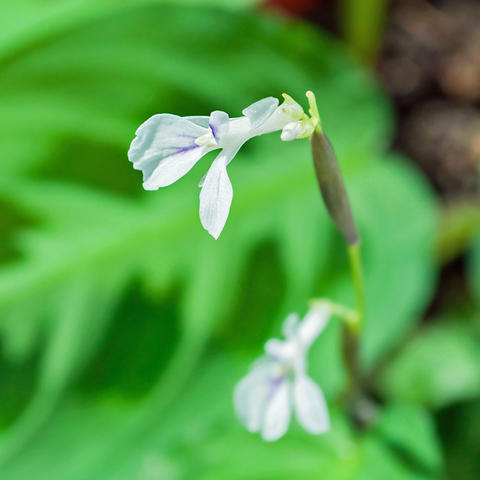Prayer Plant
Planting and caring for prayer plants as houseplants is not that easy, but their wonderfully patterned leaves are well worth the effort.
Factsheet
- Growth type
-
- Perennial plant
- Growth height (from)
- from 20 cm to 30 cm
- Growth characteristics
-
- upright
- overhanging
- horst-forming
- Flower color
-
- white
- Flowering time (month)
-
- April to May
- Flower shape
-
- Uniflorous
- Flower characteristics
-
- unimpressive
- Leaf color
-
- green
- multicolored
- page format
-
- ovoid to round
- oval
- Sheet properties
-
- evergreen
- Fruit shape
-
- Capsule
- Fruit characteristics
-
- unimpressive
- Light
-
- semi-shade
- Soil type
-
- sandy to loamy
- Soil Moisture
-
- fresh to humid
- ph value
-
- weakly acidic to acidic
- Lime compatibility
-
- sensitive to lime
- Nutrient requirements
-
- nutrient-rich
- Decorative or utility value
-
- Leaf ornaments
- Winter Hardness
-
- frost-sensitive
- Use
-
- Interior greening
- Planters
- Winter garden
- Warm House
- Garden style
-
- Pot garden
The Prayer plant (Maranta leuconeura) is a species of plant in the family Marantaceae. In this country, the tropical plant from northern Brazil can only be grown as a houseplant.
The tuft-forming herbaceous perennial has an upright growth habit. The bulbous roots produce long-stemmed large and strikingly marked leaves that drape downwards slightly. The prayer plant is evergreen and grows 7.87 to 11.81 inches tall.
The leaves of Maranta leuconeura are oval to ovate, and 3.94 to 5.91 inches long. They are alternate on long stems. The leaf blades have attractive patterns with red or pink veins and brownish or light green spots. The young leaves of the prayer plant are at first rolled up and pointed upwards, before unfurling their full splendor.
The prayer plant’s tiny white flowers are totally unremarkable in comparison to the foliage – it flowers very rarely as a houseplant in any case. Flowering occurs between April and May.

It’s even rarer to see the fruit of the Prayer plant in these parts. It develops in the form of small capsules after successful fertilization.
Finding the right location for the Prayer plant is not entirely easy: for the tropical plant to thrive, it needs similar conditions to its natural habitat. It should be in a partially shaded spot that is neither too bright nor too dark. Too much light will fade the wonderful leaf patterns and a lack of light will cause Maranta leuconeura to wither. The houseplant needs a very warm ambient temperature of 73.4 to 77 degrees Fahrenheit for most of the year. It should be slightly cooler in winter. Temperatures must not fall below 64.4 degrees Fahrenheit, but should also not exceed 77 degrees Fahrenheit. The humidity should be high all year round and at least 60 percent. The Prayer plant should also be protected from drafts and cold ground. The best place for the houseplant to thrive in the long run is a heated conservatory or titlegreenhouse. But it also develops very well in bright bathrooms.
For the substrate, you should pick up a special soil mix from a specialist store. The Prayer plant is most comfortable in well-drained, loose soil with a low, acidic pH and high nutrient content. Rhododendron soil perfectly meets these requirements and is also very easy to mix yourself.
Maranta leuconeura should only be watered using room temperature water with a low lime content. Keep the substrate moist at all times, including during winter. The Prayer plant can be watered more sparingly during the rest period of September to February, but do not allow it to completely dry out. Leaving the plant to dry out just once can have unpleasant consequences.
As a houseplant, the Prayer plant should be fertilized every two weeks, except in winter. Add a low dosage of liquid houseplant fertilizer to the water.
Young plants are repotted each year in spring, older plants can remain in the same pot for several years. Remove as much of the old soil as possible so that you can examine the roots of the Maranta leuconeura. Rotten or dried up roots should be cut off before planting.
The Prayer plant does not need pruning. Simply use scissors to remove withered leaves.

In addition to the species, there are usually only two other varieties of Maranta leuconeura available to purchase:
- ‘Kerchoveana’: more robust than the species, well suited to indoor cultivation, brownish spotted/speckled leaves
- ‘Erythroneura’: bright red leaf veins (see title image above), more attractive than the species, but also slightly more sensitive
One occasionally comes across the variety ‘Fascinator’ which has tricolor patterned leaves.
You can propagate using tip cuttings or by carefully dividing the root balls of older plants in spring. Both methods require very warm soil, high humidity and a room temperature of around 86 degrees Fahrenheit – not the easiest accomplishment for amateur gardeners.
and scale insects occur when the humidity is too low. If the plant consistently sits in too much water, this leads to root rot.

